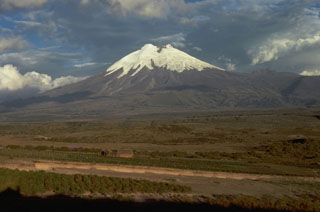Report on Cotopaxi (Ecuador) — 28 June-4 July 2023
Smithsonian Institution / US Geological Survey
Weekly Volcanic Activity Report, 28 June-4 July 2023
Managing Editor: Sally Sennert.
Written by JoAnna G. Marlow.
Please cite this report as:
Global Volcanism Program, 2023. Report on Cotopaxi (Ecuador) (Marlow, J G, and Sennert, S, eds.). Weekly Volcanic Activity Report, 28 June-4 July 2023. Smithsonian Institution and US Geological Survey.
Cotopaxi
Ecuador
0.677°S, 78.436°W; summit elev. 5911 m
All times are local (unless otherwise noted)
IG reported that moderate eruptive activity continued at Cotopaxi during 27 June-4 July. Seismic stations recorded long-period earthquakes (LPs) and eruption tremors daily; volcano-tectonic earthquakes (VTs) were detected during 27-28 and 30 June and 3-4 July. Snow and ice melted from the summit and triggered small lahars that descended the Agualongo drainage during the afternoons of 27 and 29 June and the NW flank during the afternoon of 1 July. Frequent degassing episodes were observed during 27 June-1 July; weather clouds sometimes obscured views of the summit. Ash plumes were observed in webcam and satellite images and described in aviation notices issued by the Washington VAAC during 2-3 July. The plumes rose 500-1,000 m above the crater and drifted W; ashfall was reported in El Rosal (34 km SW), Ticatilín (15 km WSW), San Agustín del Callo (16 km WSW), San Ramón (16 km WSW), and Rumipamba de Villacís (19 km WSW), all within the parish of Mulaló. The Secretaría de Gestión de Riesgos maintained the Alert Level at Yellow (the second highest level on a four-color scale).
Geological Summary. The symmetrical, glacier-covered, Cotopaxi stratovolcano is Ecuador's most well-known volcano and one of its most active. The steep-sided cone is capped by nested summit craters, the largest of which is about 550 x 800 m in diameter. Deep valleys scoured by lahars radiate from the summit of the andesitic volcano, and large andesitic lava flows extend to its base. The modern edifice has been constructed since a major collapse sometime prior to about 5,000 years ago. Pyroclastic flows (often confused in historical accounts with lava flows) have accompanied many explosive eruptions, and lahars have frequently devastated adjacent valleys. Strong eruptions took place in 1744, 1768, and 1877. Pyroclastic flows descended all sides of the volcano in 1877, and lahars traveled more than 100 km into the Pacific Ocean and western Amazon basin. Smaller eruptions have been frequent since that time.
Sources: Instituto Geofísico-Escuela Politécnica Nacional (IG-EPN), Secretaría de Gestión de Riesgos (SGR), Washington Volcanic Ash Advisory Center (VAAC)

